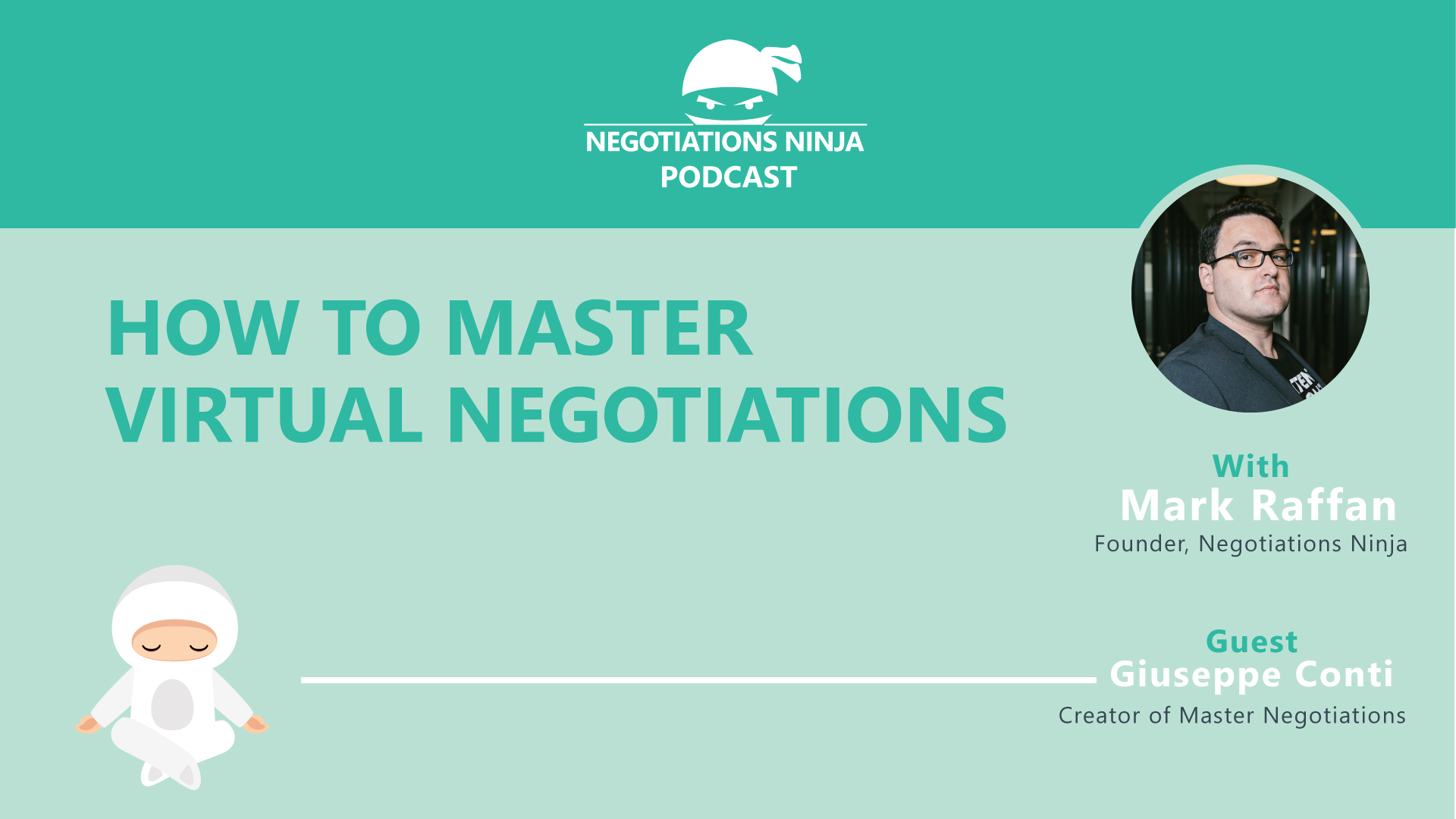What does it take to negotiate a great deal virtually? Whether by email, text, or web-based video conversation—whatever it might be—how do you get to a great deal? How do you decide what mode of communication to use? In this episode of Negotiations Ninja, Giuseppe Conti explains how to master virtual negotiations and discusses the benefits of each mode of communication and which to choose for optimal results.
Giuseppe has been in procurement for over 25 years. He’s held senior roles with Procter & Gamble, Novartis, Firmenich, and Merck—in 5 different countries. In 2005 he started teaching negotiation at a business school. Now he teaches at 14 different schools, including 10 of the top 12 names in Europe—Oxford being one of them. He helps his consulting clients negotiate real-life deals. Don’t miss out on his extensive expertise!
Outline of This Episode
- [1:40] Giuseppe Conti joins the podcast
- [3:02] The different virtual communication channels
- [5:51] The advantages of email communication
- [6:49] The importance of summarizing
- [7:50] Why we lean towards a negative interpretation
- [9:23] How to properly use email (how to write + reply)
- [14:12] Building rapport through virtual negotiations
- [16:26] Choosing the right virtual negotiation tool
- [19:55] Why you must understand your context
- [21:18] How to connect with Giuseppe
Factoring in information richness
Phone, chat, letter, email, text message—there are a variety of communication tools out there. But video conferencing has become the standard in these times. What you choose to communicate with is based on the amount of information richness that’s necessary. Information richness is the ability of the communication medium to accurately communicate to reach a shared understanding.
Giuseppe references a classical study by Albert Mehrabian in which he found 7% of communication is through words, 38% is through voice, and 55% is visual (it’s commonly referred to as the “7%-38%-55% Rule”). But he points out that we must be careful referencing this study because it doesn’t convey the full truth. What does he mean by that?
The study was conducted in a context where the participants were talking about an emotional topic. In that context, there was a discrepancy between verbal and non-verbal communication. When you’re negotiating face-to-face, those elements are present. But over video conferencing, the words are still there. The tone of voice is still there. But is the visual fully there?
We can see their facial expressions—but we can’t see their body posture or how they use space. There is some visual information that is lost. If we use the phone, we completely lose the visual. If we use email, we only get words. Guiseppe points out that the first lesson we can take is that words are always there: “So do make sure that your written communication is powerful.”
Proper email communication
If we want people to default to video communication as much as possible, where is the place for email? What should we use it for? Giuseppe points out that email is still a valid tool for negotiations, especially for someone who is an introvert. Email offers several advantages. You can avoid being emotional and manage its effectiveness. It’s less stressful. It gives you more time to think through strategy.
Email is a great tool for hard bargaining where there is little need to build a relationship. Giuseppe notes that you may even dare to ask a question over email that you wouldn’t ask face-to-face. How does summarizing information in emails change the power dynamic? Why are we prone to negative interpretations of emails? Listen to find out!
Diversify your use of communication tools
Giuseppe recommends being careful with only having one tool that you lean on heavily. He compares it to being a good tennis player: you must have a good forehand, backhand, volley, and serve. If you want to do everything with a forehand—even if it’s a fantastic forehand—you won’t be likely to win as much. If your opponent is a great player, versed in every move, you’ll have a difficult time winning at all. What’s the key to winning with emails? Keep listening to hear Giuseppe’s thoughts!
Choosing the right virtual negotiation tool
Giuseppe wants you to question: What is the goal of your communication? If you want to build rapport, choosing video communication is the better option because it’s the closest to face-to-face interaction. If the goal is just a quick clarification or trying to resolve a misunderstanding, a phone call might suffice. Emails may be the right tool for a detailed proposal. A text message can work if you’re trying to progress more quickly than an email.
The key message? Giuseppe emphasizes that you must “Learn to mix the different virtual tools and be able to apply the right one.” You cannot rely heavily on one tool over another. It reduces your ability to communicate in different contexts or circumstances. How important is the context for choosing a communication medium? Giuseppe shares his thoughts—don’t miss it!
Resources & People Mentioned
- Albert Mehrabian’s “7%-38%-55% Rule”
Connect with Giuseppe Conti
- Connect on LinkedIn
- Subscribe to Giuseppe’s newsletter for a FREE negotiation pack!
Connect With Mark
- Follow Negotiations Ninja on Twitter: @NegotiationPod
- Connect with Mark on LinkedIn
- Follow Negotiations Ninja on LinkedIn
- Connect on Instagram: @NegotiationPod




